Fan Tan uses the standard 52 deck in which the cards rank in the following order (from high to low); King, Queen, Jack, 10, 9, 8, 7, 6, 5, 4, 3, 2, Ace. Fan Tan is designed for play by 3 to 6 players.
The standard method of scoring in Fan Tan is done using tokens or chips. Thus, before beginning the game, each player should be distributed an equal number of chips, such as 50 or 100. These chips will be used to keep score through multiple hands.
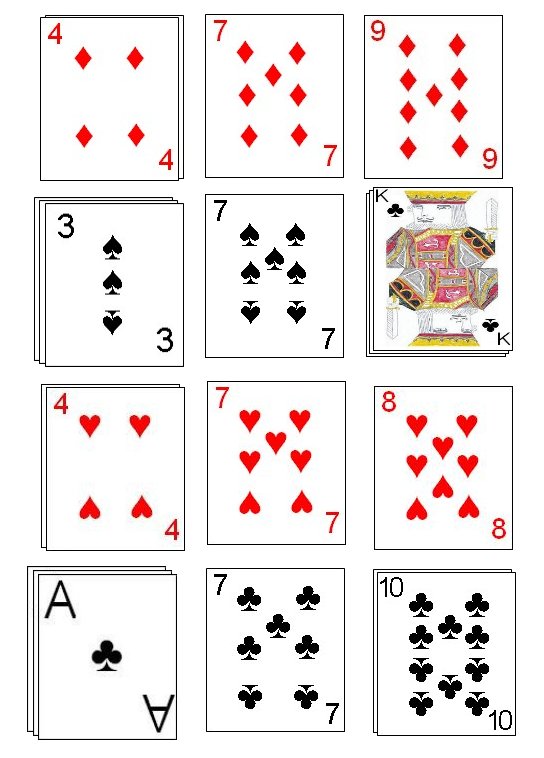 |
| This illustration shows a layout for a game of Fan Tan in progress. The sevens are played to the middle, and cards of a higher denomination in piles to the left of these and cards of ascending denomination in piles to the right. |
The object of each hand is to be the first player to eliminate all cards from his hand. The first player to do so will win all the chips in the center of the table and additional penalty chips from the remaining players as well. That same player will also become the dealer for the next hand.
Once all cards have been dealt the players then pick up their cards to begin play of the hand. The player to the dealer's left has the first play, with normal play rotating in a clockwise rotation.
On his turn, each player plays a card if able, to a center layout or tableau. The legal plays in this game are as follows:
- A player may always play any Seven from his hand to the layout as a foundation card. Each seven played should be on it's own, new row in the layout.
- Once a seven of a particular suit has been played a player may then play the eight of the same suit, placing it on one side of the Seven. After the eight has been played, player may build up on that eight to the King in the same suit. These cards are usually played directly on top of the last card in the ascending sequence for this seven.
- Similarly, a player may play the six of the same suit as the Seven, placing it on one side of the seven. Once the six has been played, players may then build down from the six to the Ace in that same suit. These cards are usually played directly on top of the last card played on that side of the seven.
The tableau essentially becomes four rows of cards, with one row for each suit, with the sevens being placed first. Each separate row is called a fan. Once a seven has been played, it opens the layout for additional cards of the same suit. The six of the same suit would be played to one side of the seven and the eight on the other side. Players can then build on these cards in a descending order from Seven to Ace and ascending order up from Seven to King in the same suit.
When a player on his turn is able to play his last card, the hand ends. Each other player must then add one chip to the center of the table for each card remaining in their own hand. The player who ran out of cards then collects all the chips from the center and shuffles the deck and deals the next hand.
If a player on his turn fails to play a card when he had a legal play, he must add three chips from his hand to the center of the table at the end of the hand. If a player who has a seven passes, he must place three chips in the center and also, as an additional penalty, give the players who have the six and the eight of the same suit as that seven 5 chips each.
At the end of a set number of hands, the player who has the most total chips is declared the winner. Usually each player is given enough chips such that no player will run out, but if a player does run out of supplied chips, the game ends at the completion of the current hand, with the player having the most chips declared the winner.

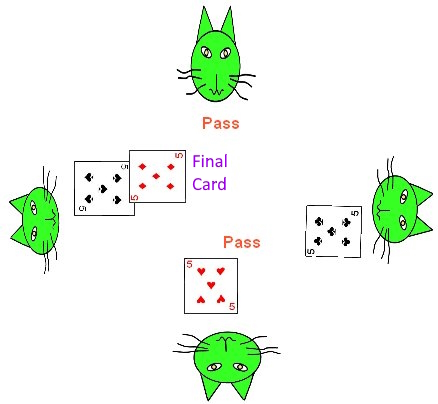
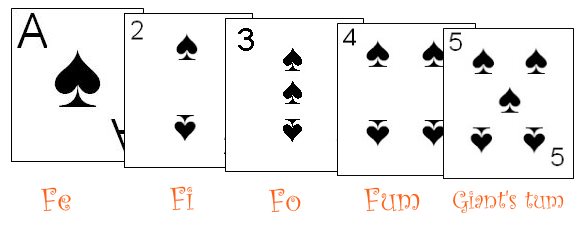 Fe-Fi-Fo-Fum: Fe Fi Fo Fum is another Children's game which plays very similarly to Earl of Coventry. This game is designed for four to six players and uses one standard 52 card deck. The ranking of the cards in the deck are as follows: Ace, 2, 3, 4, 5, 6, 7, 8, 9, 10, Jack, Queen, King.
Fe-Fi-Fo-Fum: Fe Fi Fo Fum is another Children's game which plays very similarly to Earl of Coventry. This game is designed for four to six players and uses one standard 52 card deck. The ranking of the cards in the deck are as follows: Ace, 2, 3, 4, 5, 6, 7, 8, 9, 10, Jack, Queen, King.
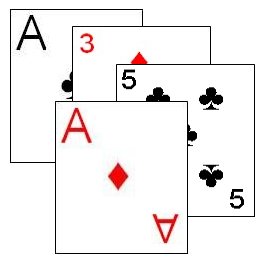
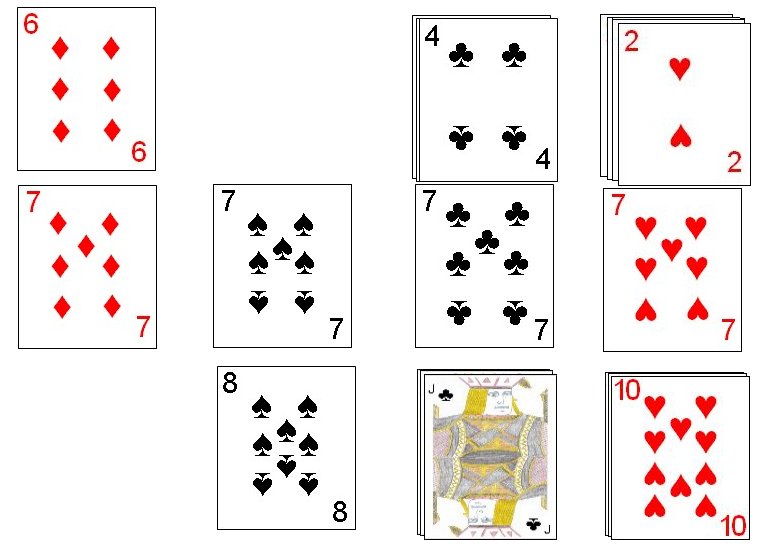 The player holding the seven of Clubs has the first turn and must play this card as his first turn. Subsequently the turn rotates in a clockwise rotation from that player around the table.
The player holding the seven of Clubs has the first turn and must play this card as his first turn. Subsequently the turn rotates in a clockwise rotation from that player around the table.
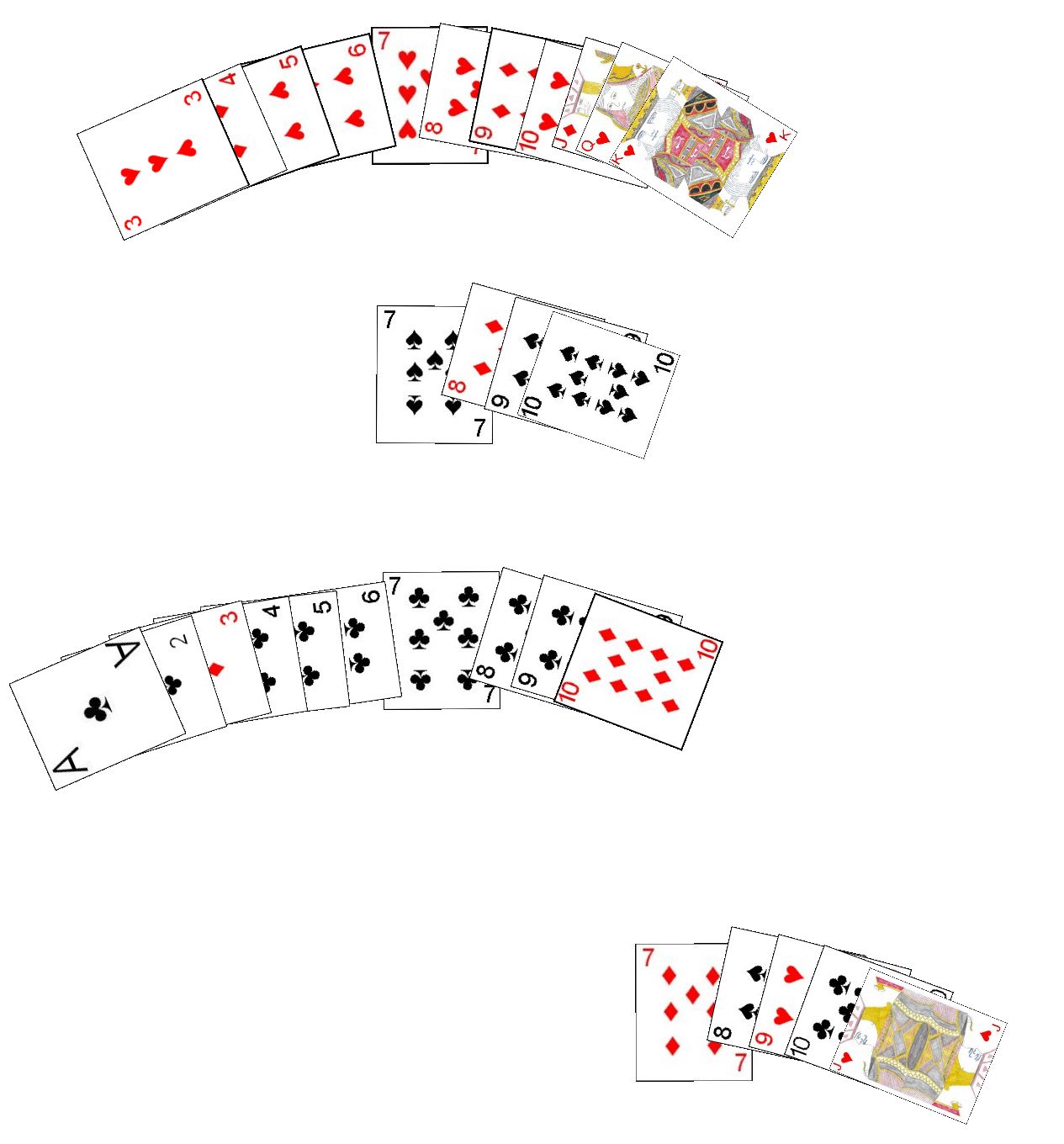
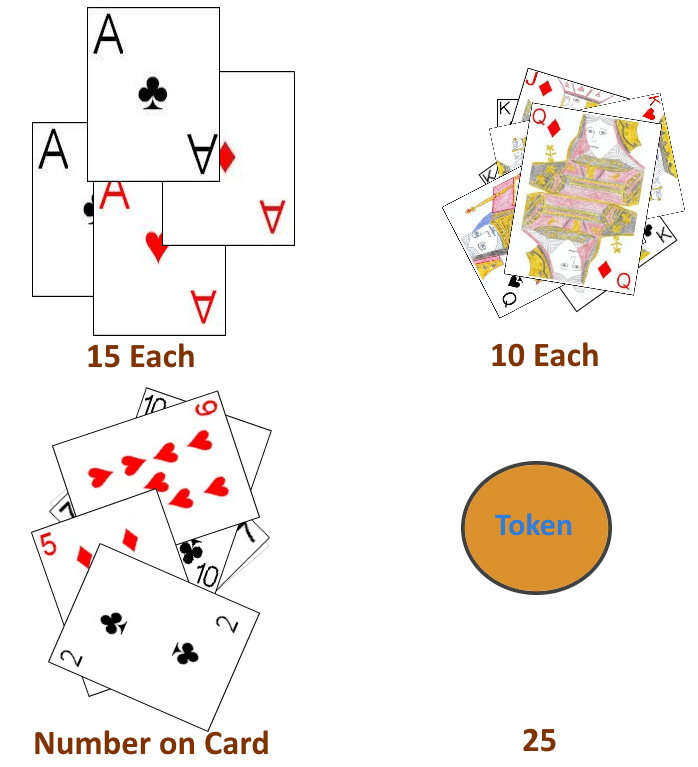
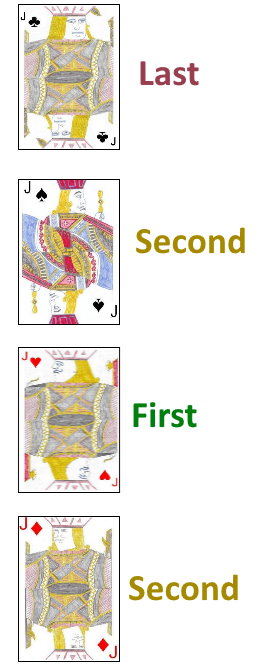 Once the hands have been dealt, play begins. Whichever player has the Unter (Jack) of Hearts has the first turn, in which he must play that card to the middle of the table to start a foundation. Play then continues in a counter-clockwise direction from that player around the table from player to player. Players may then build up or down from this foundation card with cards of that same suit. Thus, if the next player has either the Ober or 10 of Hearts he may play it to the table near that foundation card to continue the sequence. The lowest card in a sequence is the 7 and the highest card is the Sow (Ace). If a player on his turn does not have a card which can be added to the sequence, he may also be able to play another Unter if he has one. There is also a specific order for the order in which the Unters are to be played. After the Unter of Hearts has been played, the Unter of Leaves may be played to start a foundation directly above the Unter of Hearts or the Unter of Bells may be played to start a foundation directly below the Unter of Hearts. Once the Unter of Leaves has been played, the Unter of Acorns can be played to start a new foundation above the Unter of Leaves. A player may play a maximum of one card on his turn and must make a play if he has at least one legal play. However, if a player cannot make a play, he must instead pass on that turn.
Once the hands have been dealt, play begins. Whichever player has the Unter (Jack) of Hearts has the first turn, in which he must play that card to the middle of the table to start a foundation. Play then continues in a counter-clockwise direction from that player around the table from player to player. Players may then build up or down from this foundation card with cards of that same suit. Thus, if the next player has either the Ober or 10 of Hearts he may play it to the table near that foundation card to continue the sequence. The lowest card in a sequence is the 7 and the highest card is the Sow (Ace). If a player on his turn does not have a card which can be added to the sequence, he may also be able to play another Unter if he has one. There is also a specific order for the order in which the Unters are to be played. After the Unter of Hearts has been played, the Unter of Leaves may be played to start a foundation directly above the Unter of Hearts or the Unter of Bells may be played to start a foundation directly below the Unter of Hearts. Once the Unter of Leaves has been played, the Unter of Acorns can be played to start a new foundation above the Unter of Leaves. A player may play a maximum of one card on his turn and must make a play if he has at least one legal play. However, if a player cannot make a play, he must instead pass on that turn.
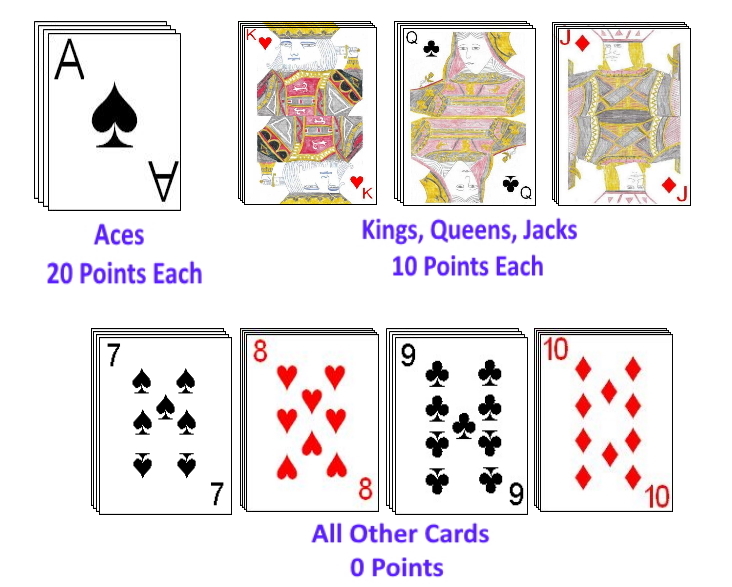
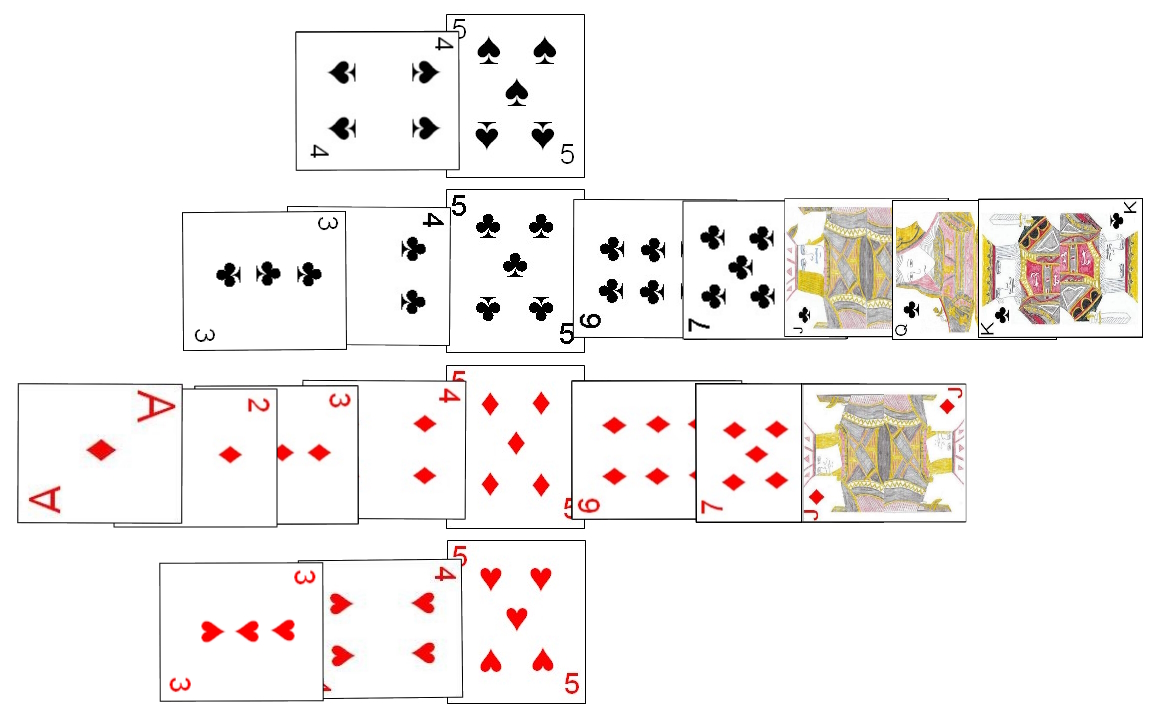 Cinquillo: Cinquillo is the primary variant of Fan Tan played in Spain. Cinquillo is commonly played by 2 to 5 participants and is traditionally played using the 40 card Spanish suited deck. The Spanish deck consists of four suits (coins, glasses, clubs, and swords). In each of these four suits is one card in each of the denominations of King, Knight, Jack, 7, 6, 5, 4, 3, 2, and 1. If such a Spanish suited deck is not at hand, a standard International deck can be used by removing all cards in the denominations of 8, 9, and 10. The sequencing and rank of the cards in this deck are as follows (from highest to lowest): King, Knight (Queen), Jack, 7, 6, 5, 4, 3, 2, 1 (Ace). It should be noted that the Jack is next in ascending order after the seven in this deck.
Cinquillo: Cinquillo is the primary variant of Fan Tan played in Spain. Cinquillo is commonly played by 2 to 5 participants and is traditionally played using the 40 card Spanish suited deck. The Spanish deck consists of four suits (coins, glasses, clubs, and swords). In each of these four suits is one card in each of the denominations of King, Knight, Jack, 7, 6, 5, 4, 3, 2, and 1. If such a Spanish suited deck is not at hand, a standard International deck can be used by removing all cards in the denominations of 8, 9, and 10. The sequencing and rank of the cards in this deck are as follows (from highest to lowest): King, Knight (Queen), Jack, 7, 6, 5, 4, 3, 2, 1 (Ace). It should be noted that the Jack is next in ascending order after the seven in this deck.
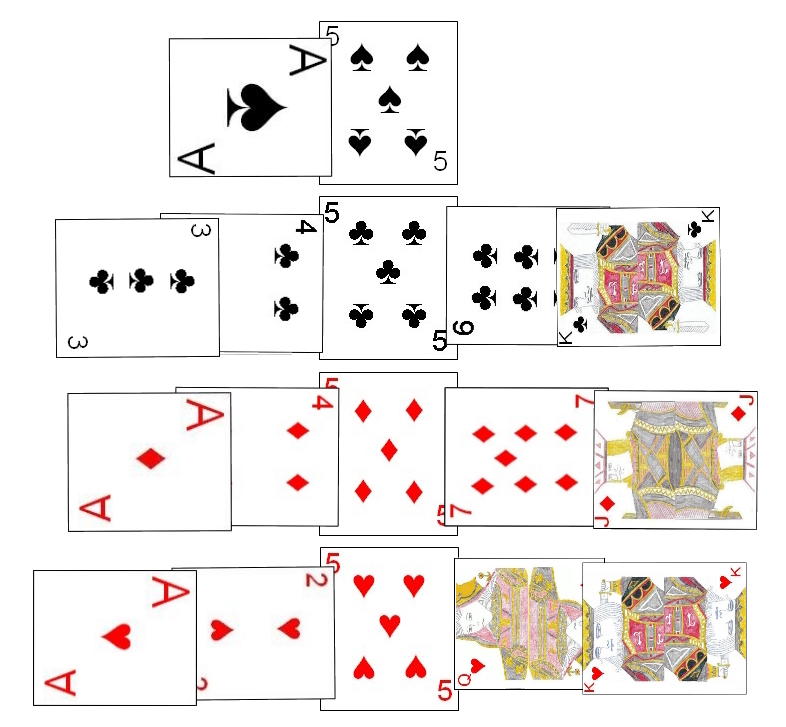 Blocked Cinquillo: This is a unique variant of standard Cinquillo which is much less common than the regular version. This variation is normally played by 3, 4, or 5 players. It is similar to standard Cinquillo with the following major differences:
Blocked Cinquillo: This is a unique variant of standard Cinquillo which is much less common than the regular version. This variation is normally played by 3, 4, or 5 players. It is similar to standard Cinquillo with the following major differences:
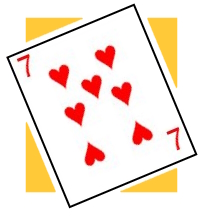 To begin the deal, the dealing player should thoroughly shuffle the deck and offer it to the player at his right to cut. After the cut the dealer begins dealing the cards in a clockwise direction around the table, starting with the player at his immediate left. The cards are dealt face-down and one-by-one, with the dealer continuing the deal until the entire deck has been dealt out.
To begin the deal, the dealing player should thoroughly shuffle the deck and offer it to the player at his right to cut. After the cut the dealer begins dealing the cards in a clockwise direction around the table, starting with the player at his immediate left. The cards are dealt face-down and one-by-one, with the dealer continuing the deal until the entire deck has been dealt out.